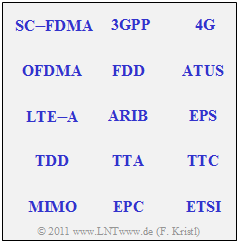Difference between revisions of "Aufgaben:Exercise 4.1: General Questions about LTE"
| Line 17: | Line 17: | ||
''Notes:'' | ''Notes:'' | ||
| − | * | + | *This task belongs to the chapter [[Mobile_Communications/Allgemeines_zum_Mobilfunkstandard_LTE|Allgemeines zum Mobilfunkstandard LTE]]. |
| − | * | + | *IThe chart shows some LTE-relevant terms. However, there is no direct reference to the task. |
| − | === | + | ===Questionnaire=== |
<quiz display=simple> | <quiz display=simple> | ||
| − | { | + | {Which important innovations were described by 3GPP in release 8? |
|type="[]"} | |type="[]"} | ||
| − | + | + | + A purely packet-oriented transmission, |
| − | + | + | + a high spectral efficiency, |
| − | + | + | + Frequency or bandwidth flexibility, |
| − | - | + | - low energy consumption at the base stations. |
| − | { | + | {What is the duplex gap of the LTE frequency band around $800 \ \rm MHz$ for? |
|type="[]"} | |type="[]"} | ||
| − | - | + | - For the realization of the ''Cyclic Prefix'', |
| − | + | + | + to avoid interference between uplink and downlink, |
| − | - | + | - to avoid overlapping between individual providers. |
| − | + | + | + The duplex gap is also used to operate wireless microphones. |
| − | { | + | {What methods and techniques does LTE <u>mainly</u> use ? |
|type="[]"} | |type="[]"} | ||
+ OFDMA, | + OFDMA, | ||
| Line 46: | Line 46: | ||
- CDMA. | - CDMA. | ||
| − | { | + | {How do the frequency bands differ by $800 \ \rm MHz$ or by $2.6 \ \rm GHz$? |
|type="[]"} | |type="[]"} | ||
| − | + | + | + By different prices at the auction. |
| − | + | + | + In the frequency band around $800 \ \rm MHz$ there are only paired frequencies. |
| − | - | + | - The frequency band around $2.6 \ \rm GHz$ can only be used for FDD. |
| − | + | + | + The areas of application differ fundamentally. |
| + | |||
</quiz> | </quiz> | ||
| − | === | + | ===Sample solution=== |
{{ML-Kopf}} | {{ML-Kopf}} | ||
Revision as of 12:20, 10 July 2020
Since 2011, mobile communications systems have already reached the fourth generation, without serious delays, as was the case with the second generation of mobile communications (GSM) and even more so with the third generation (UMTS). Currently (2017) "5G" is the all-dominant buzzword. However, the author does not allow himself any more precise statements about the time of introduction than "very soon" or "as soon as possible". More detailed information can be found here.
The development of new "releases" is constantly being driven forward by 3GPP. This international consortium, which includes all major mobile operators and manufacturers worldwide, will continue to play a prominent role in mobile communications in the future.
LTE has been offered commercially since 2011, especially for sparsely populated rural areas without sufficient DSL broadband connections. This 4G mobile communications standard is gradually becoming more widespread.
Notes:
- This task belongs to the chapter Allgemeines zum Mobilfunkstandard LTE.
- IThe chart shows some LTE-relevant terms. However, there is no direct reference to the task.
Questionnaire
Sample solution
(1) Richtig sind die Antworten 1 bis 3, die auch für die wichtigsten Verbesserungen durch LTE stehen:
- Ein niedriger Energieverbrauch an den Basisstationen ist ausdrücklich falsch, denn es geht um einen möglichst niedrigen Energieverbrauch bei den Endgeräten, wofür sogar ein erhöhter Energieverbrauch an den Basisstationen in Kauf genommen wird.
(2) Richtig sind die Antworten 2 und 4:
- Der entscheidende Grund für die Duplex–Lücke ist es, einen Sicherheitsbuffer zwischen Uplink und Downlink zu schaffen.
- Aber auch Antwort 4 ist richtig: Funkmikrofone wurden und werden auch momentan noch mit Frequenzen im Bereich um 800 MHz betrieben, also bei solchen Frequenzen, die jetzt für LTE gebraucht werden.
- Wenn LTE endgültig flächendeckend ausgebaut ist, so kommt es zu Beeinträchtigungen von leistungsschwächeren Funkmikrofonen.
- Darüber hinaus ist für die Jahre nach 2015 der Einsatz von Veranstaltungstechnik auf den LTE–Frequenzen verboten. Unter anderem deshalb gibt es diese Duplex–Lücke, aber das ist nicht der eigentliche Grund, sondern ein nützlicher Nebeneffekt.
(3) Richtig sind die drei ersten Antworten:
- OFDMA kommt im Downlink von LTE zum Einsatz, SC–FDMA im Uplink.
- Mehrantennensysteme (englisch: Multiple Input Multiple Output, MIMO) kommen im Mobilfunk häufiger zum Einsatz, nicht nur bei LTE.
- Tatsächlich wird bei LTE aber auch CDMA eingesetzt, allerdings nur für Kontrollkanäle.
(4) Richtig sind die Antworten 1, 2 und 4:
- Der höherfrequente 2600 MHz–Bereich ist insbesondere aufgrund von Auflagen der Bundesregierung und wegen der geringeren Reichweite für Großstädte interessant.
- Der nur aus gepaarten Frequenzen bestehende 800 MHz–Bereich wird vorwiegend für ländliche Gebiete genutzt werden.
